Family : Alaudidae

Text © Dr. Gianfranco Colombo

English translation by Mario Beltramini
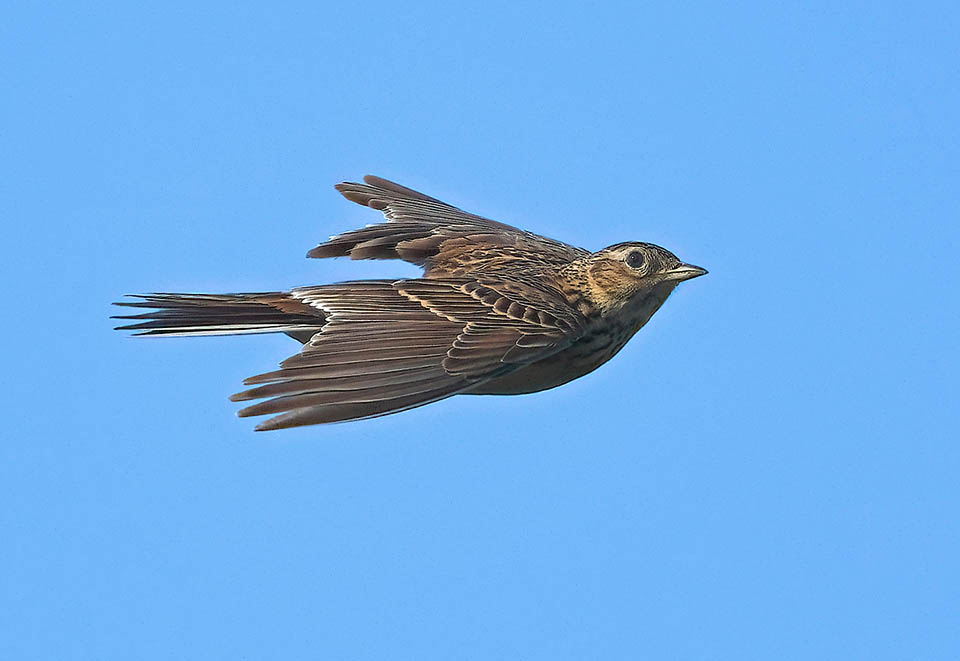
The Lark (Alauda arvensis) has a very vast range, from Europe to the shores of Pacific up to Japan © Pete Blanchard
The Lark or Eurasian skylark (Alauda arvensis Linnaeus, 1758) belongs to the order of the Passeriformes and to the family of the Alaudidae and is the most common and best known species in our countries.
The legend tells that upon the death of St. Francis, hundreds of singing larks rose into the sky, to thank him for the affection received when he was alive. But this small bird, so dear to those frequenting nature, has a history lost in the mists of time and through memories, legends, stories and truths has reached our days, going beyond with its grace and sweetness, centuries of human vicissitudes.
Pliny derives the name “alauda” from the Celtic language, with the meaning of great singer, “al”, great and “aud” song. The Romans were so fascinated by it that Caesar called one of his legions in Gaul “alauda”. Later on, Plutarch elevates it to the rank of symbol of the symbol of good, as had defeated an invasion of locusts and in the old Indian religiosity they indicate it as an archetype of wisdom and spirituality.
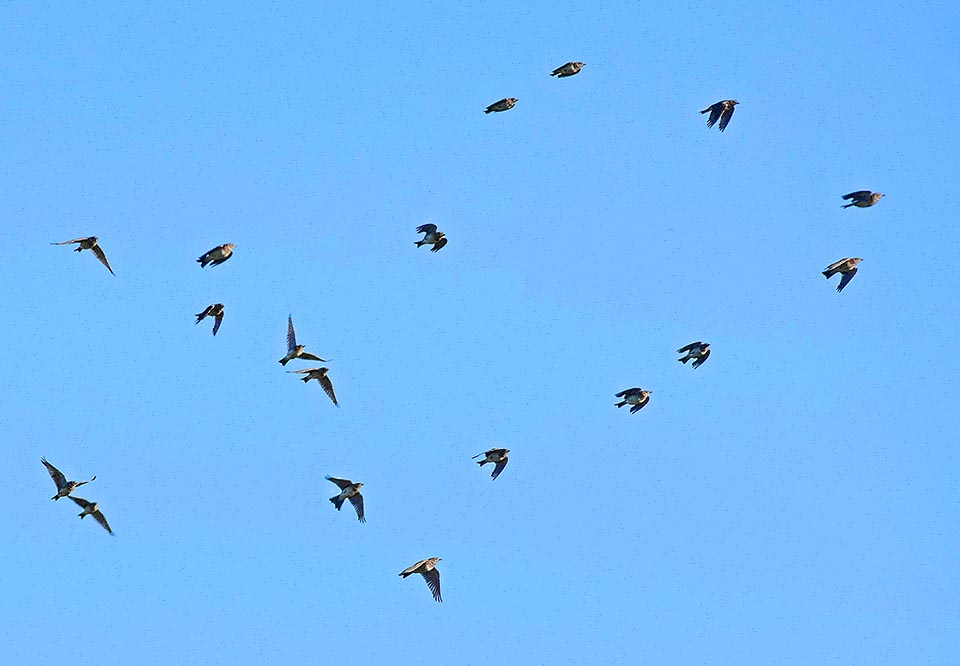
In Europe it’s mainly not migratory with winter movements of the northernmost populations to the Mediterranean area © Gianfranco Colombo
In Northern European mythology as protector of the countryside and spirit of the harvest and in the Middle Ages representation of Christ ascending to heaven. But it’s in the poems and in the literature that the Lark reaches its peak. Both, It and the nightingale (Luscinia megarhynchos) are undoubtedly the two most cited birds in all time poetic works. Metaphor of the union between sky and earth and of the rise again with new life for the first and of the sweetness and of passion for the second. Dante had thought of it placing it even in the Paradise of his Divine Comedy mentioning it in the verset:
Like a young lark which, as it soars through space, first sings, and then is silent, satisfied with the last sweetness which contented her; such seemed to me the image off the seal …….
No less Shakespeare who places it in his tragedy Romeo and Juliet, as herald of the morning after the night of love, in antagonism with the Nightingale itself, pronubial of the nocturnal passion.
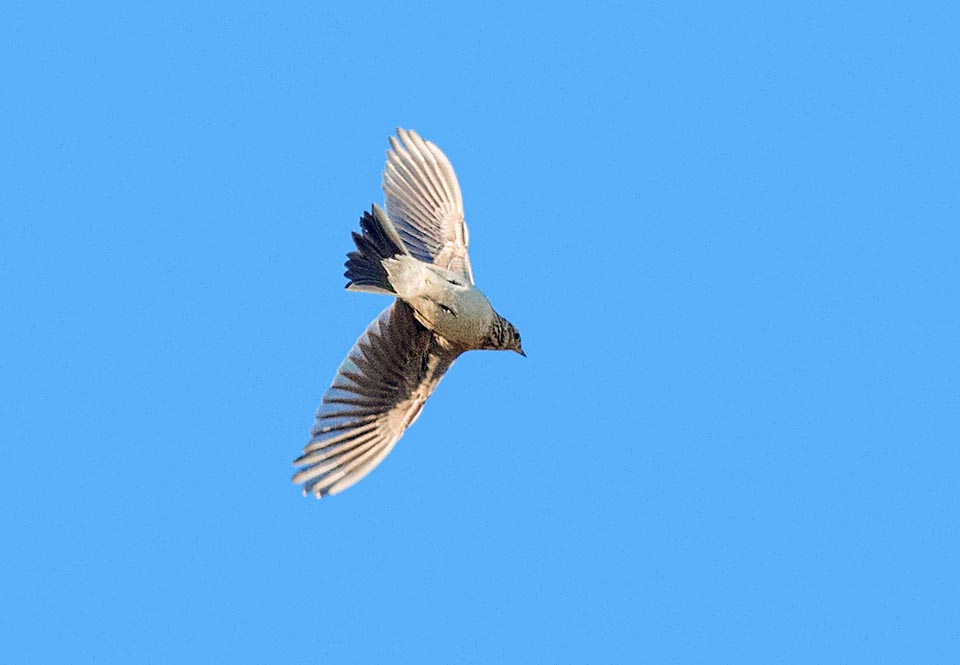
The almost perfect vertical spiral flight with a crescendo of melodious trills is amazing. Then turns to itself and falls to the ground like a stone without interrupting the song © Gianfranco Colombo
It was the lark, the herald of the morn, No nightingale: look, love, what envious streaks do lace the severing clouds in yonder east.
Not to forget, then, our poet Pascoli who sang the praises of all the birds:
….ask the sweet lark, who from time to time for the desire for better bait wants to get up to meet the dawn….
Many other poets of all times have cited it in their rhymes but it’s sufficient to remember how a simple French-Canadian lullaby exploited at the times, seems for keeping the rhythm with the rowing strokes of the fur trappers and in more recent times by children of all ages, has spread the name of Lark all over the world.
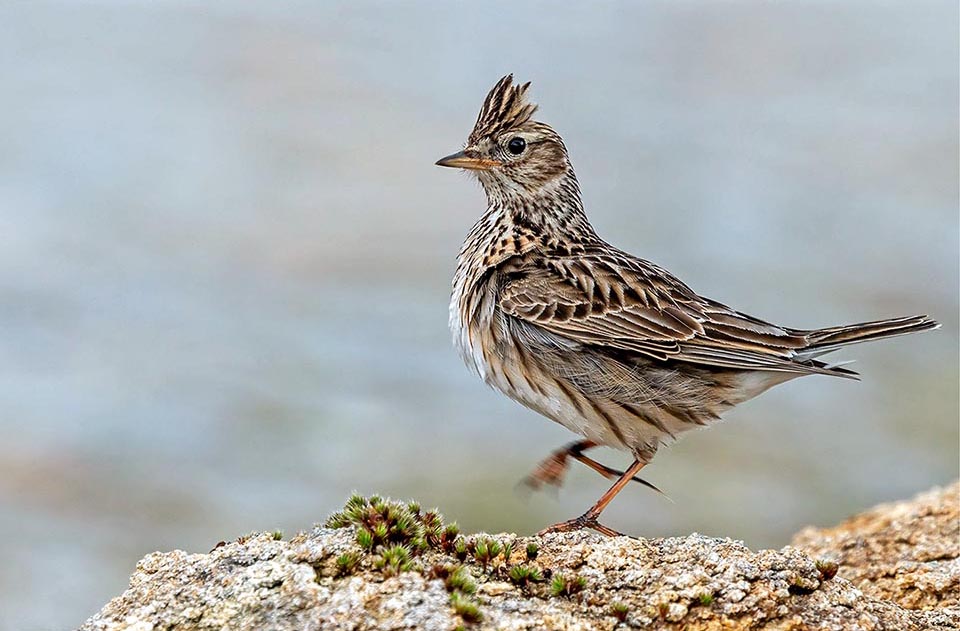
On the soil we then discover that actually it’s a terrestrial bird with a very long thumbnail for walking fast on the ground © Manuel Amaro Carvalho
Who does not remember Alouette gentille alouette, alouette, je te plumerai……
This spiritual love of humanity for the Lark is however badly reciprocated by the hunters who for it have a much more material interest, as they hunt it since ever and with determination due to the delicacy of its flesh.
So ancient is such tradition that one of the hunting methods used since centuries, has become a common saying in the Italian language: “the skylark decoy” (bait-and-switch) to indicate something attracting curiosity. In effect this little bird is attracted by the shiny objects, some say because it vaguely resembles the eyes of a raptor, particularly the Little owl (Athene noctua) for which it feels the same innate attraction but practically its reason is not yet fully known. A behavioural analogy with the Eurasian magpie (Pica pica) also attracted by shiny objects so much that it is called “thief” due to the joy it displays to get possession and hiding them.
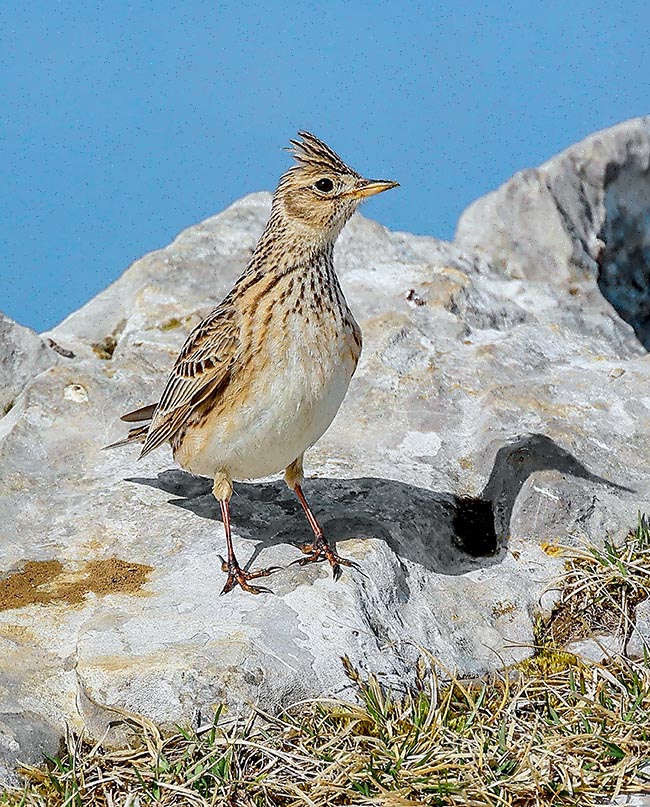
18 cm long with about 30 cm of wingspan, it has on the head a small tuft erected and lowered after the mood © Bruno Dentesani
The etymology of the genus Alauda has, as previously said, a first classical version but a second one exists that wants it to derive from a religious interpretation, consequent to the behaviour of the Lark when flying towards the sky that seems to want to pay homage to God.
“A lauda”, in Latin, rightly means “with praise”.
The species arvensis, always from the homonymous Latin term, indicates the fields, its usual habitat.
The territorial flight of the Lark is somewhat spectacular and the song accompanying it is no less.
A very tightly spiralled flight almost in a perfect vertical towards that very bright spring sky, until it disappears from sight, musical phrases that spread for hundreds of metres all around, then suddendly but without interrupting the song, here it falls to the ground like a stone, as if it wanted to crash to the ground but held back by a sudden veer that places it gently on the grass.
An unforgettable spectacle and extremely romantic if observed while lying in a spring field face up, among the flowers, looking at the sky.
In Italian it is called Allodola, in German Feldlerche, in Spanish Alondra de Eurasia, in French Alouette des champs and in Portuguese Laverca.
Zoogeography
The summer range occupied by the Lark is very wide and covers all Europe from the Mediterranean coasts up to reaching the northern shores of the continent. Its presence continues incessantly on the Asian territory up to touch the shores of the Pacific Ocean covering Kamchatka and, southwards, Japan.
South Asia does not see populations of this species therefore the nidification range stands north of the 40° parallel with a latitude line that starting from Korea joins Europe in the Caucasus zone. Naturally, south of this limit are present several other species of larks quite similar but classified separately.
Only exception is a narrow strip of territory that passes south of the Caspian Sea and joins with Anatolia.
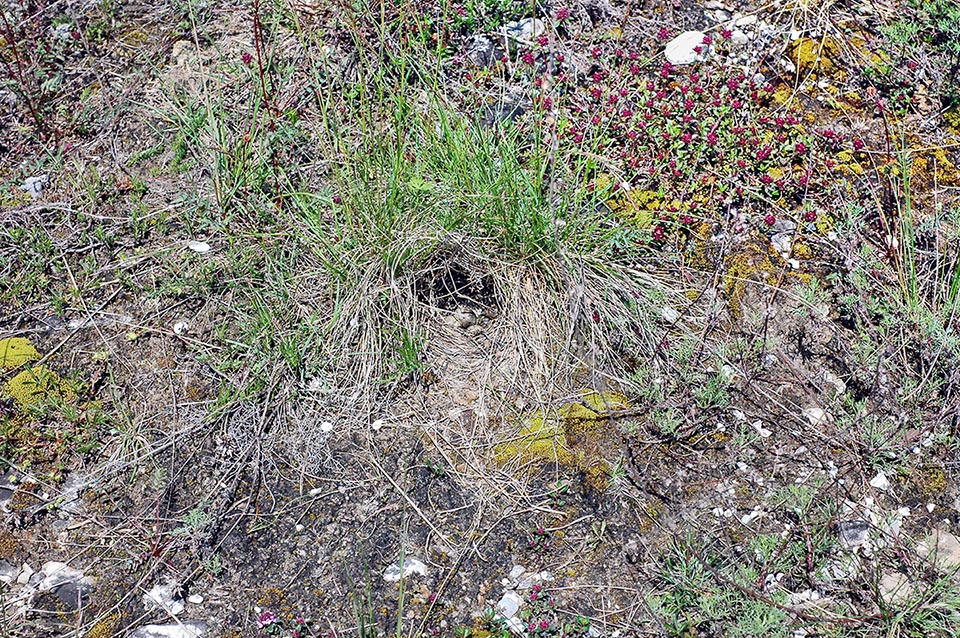
The nest is placed on the ground in a dimple dug by the female and covered with thin dry glass blades to form a comfortable and deep cup © Gianfranco Colombo
It is present also in the north-western part of Africa, from Morocco to Tunisia. It is missing or is rather occasional in Greece and in Portugal. The European populations are mostly sedentary with winter movements of the populations located further north towards the Mediterranean area whilst the Asian ones are mainly migratory and move to areas well distant from the nesting sites.
The Lark has been introduced in New Zealand and in southern Australia in the state of Victoria where it has reproduced and successfully diffused.
Ecology-Habitat
Alauda arvensis, as per the scientific name, frequents the fields and the countries both cultivated and uncultivated, the pastures and the steppe lands at the limit of a pre-desert environment, sandy dunes, hill slopes as well as high altitude meadows.
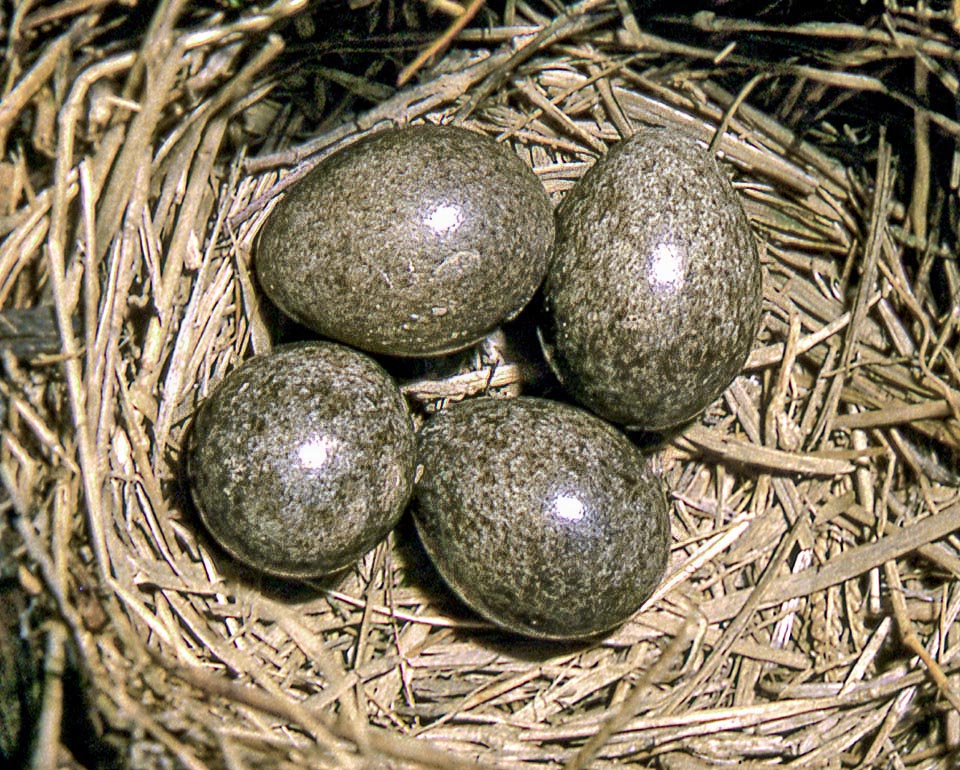
3-5 eggs are laid, of cream colour highly speckled with grey so much to render them dark and similar to the substratum, that hatch after only 11 days © Museo Civico di Lentate sul Seveso
It absolutely despises woody or densely wooded areas, as well as marshes or swampy areas. Likewise, even reaching notable altitudes, it does not love predominantly rocky or having no lawns terrains.
In winter, in the migratory quarters, it often adapts to places well different from its usual habitat and can be seen frequenting, when the land is suddenly covered by snow, along streams, water meadows and areas without snowy coverage but only with the purpose of looking for food. During these weather events we can often observe sudden migratory movements with flocks with hundreds of individuals moving towards areas not affected or concentrated in places where there is an availability of food sufficient to overcome the unexpected calamity.
A Lombard tradition tells that the Lark resists in a site until when the snow cover does not exceed the length of the blade of grass it eats to survive.
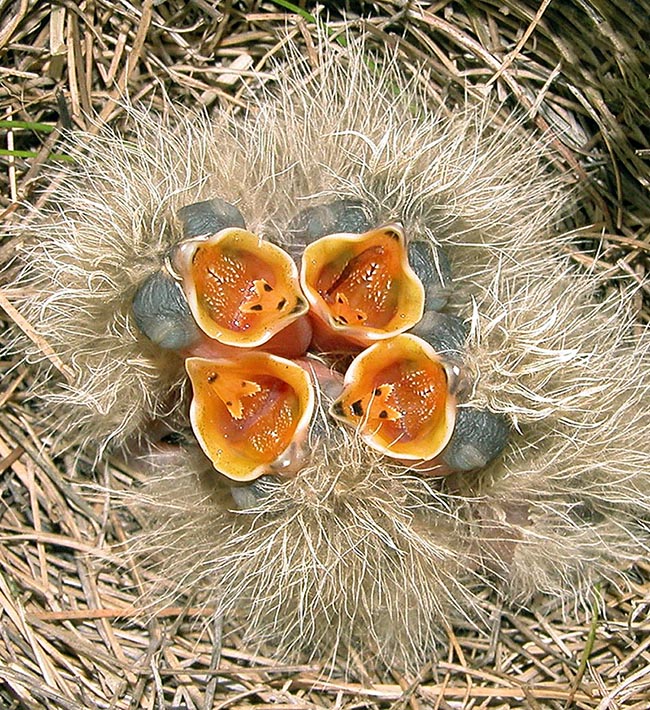
Here four very hungry chicks. They are born naked and blind with a light soft mimetic down along all the body © Richard Castell
Morphophysiology
The Lark is a small passeriform that measures 18 cm in length, the weight of 35 g and a wingspan of about 30 cm.
The colour of the livery is rather insignificant being totally ochre yellow more marked on the back where it appears variegated by the vexilla of the remiges and alar coverts that create more or less accentuated brown and greyish streaks.
A very matching colour for camouflaging with the soil on which it always stands. There is no significant distinction between the sexes and also the juveniles bear since their adolescence a livery very similar to the adults’ one.
The chest is lightly spotted with short vertical streaks that disappear on the belly which is totally cream white.
The head has a small tuft that can be raised or lowered voluntarily when the subject is excited or intrigued by external factors, as a signal of defense or of fear of attackers.
The yellowish beak with blackish tip, is long, pointed, conical and well accentuated. The eye is very black and the tail has the lateral rectrices with an external white vexillum.
A peculiarity of this alaudid is the presence of a very long thumb nail, at times even longer than the toe itself, as indication that the bird is purely terricolous and suitable for walking quickly on the ground. As a matter of fact, the lark is bound to the ground and never perches on branches of trees and not even on low shrubs as is, conversely, done by the Woodlark (Lullula arborea) or the Corn bunting (Emberiza calandra) quite similar birds even if the latter does not belong to its family.
Another consimilar not easy to distinguish when on the ground semi-hidden by grass, is the Crested lark (Galerida cristata) a perfect reproduction of the lark but with a more prominent beak and a tuft perpetually raised. Even more the Greater short-toed lark (Calandrella brachydactyla) having gentler features but somewhat similar to our species.
The Lark however loves to look around the environment climbing on raised clods or lumps of the ground avoiding the inconvenience of not being able to hug a branch also due to the length of the nail of the back toe.
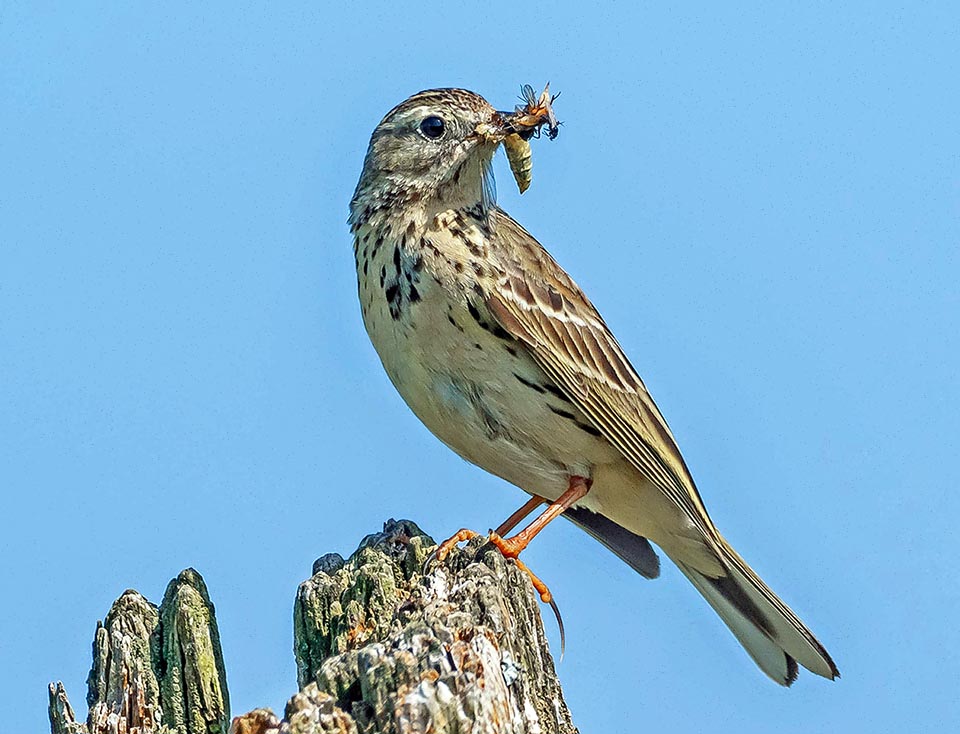
For a fast growth, the pulli are fed with insects by both parents, but the adults eat also seeds © Roy Peacock
Often this curiosity is however resolved by taking off into the sky and starting that musical refrain that may last endlessly even for tens of minutes.
Several subspecies have been classified, considering the very vast range occupied and the plurality of environments frequented, some of them previously considered as autonomous species. Among these some of European relevance such as the Alauda arvensis arvensis, typical of the European continent. Alauda arvensis sierrae of Portugal and Spain, Alauda arvensis harterti of North Africa and Alauda arvensis cantarella, of the southern band of the Mediterranean regions.
Others interest Asian zones: Alauda arvensis armenica of Iran and Caucasus, Alauda arvensis dulcivox of Russia up to Siberia and China. Alauda arvensis kiborti south of this range, Alauda arvensis intermedia of Manchuria and Korea, Alauda arvensis pekinensis of the extreme Pacific coasts, Alauda arvensis lonnbergi relegated to Sakhalin island and Alauda arvensis japonica of Japan and of the nearby archipelagoes.
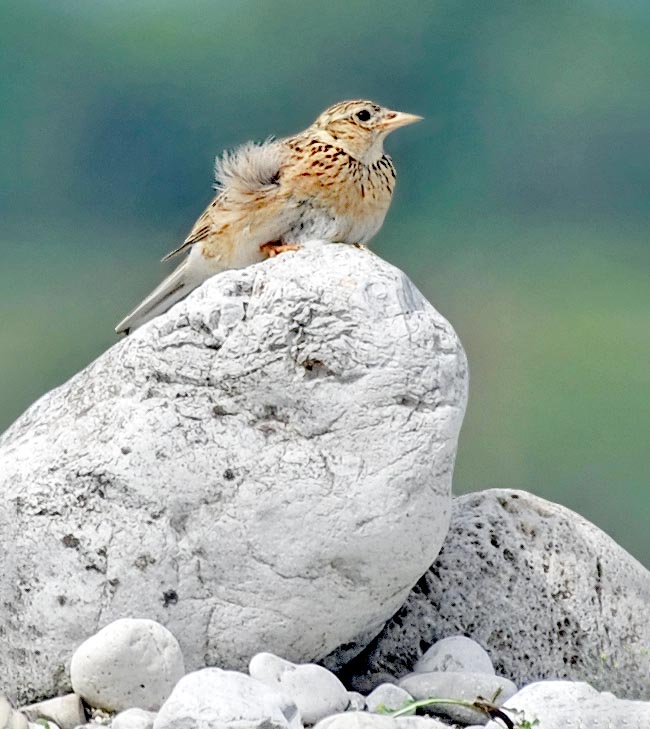
As they can’t perch on trees due to the enormous thumbnail that prevents the gripping, the Lark usually chooses an elevated point on the ground where it crouches in order to control the surrounding territory © Gianfranco Colombo
Ethology-Reproductive Biology
It has been ascertained that the male of the Lark has a wing extension significantly wider than the female proving the need to have a greater lift for performing the aforementioned famous singing flights and the unbelievable brakes after the feigned dead-weight falls to the ground.
A large part of the life of the Lark is linked to the parade song that can begin already upon the first signs of spring up to late autumn, well beyond the nesting period, as if it still wanted to keep in touch with the partner or for defending to the bitter end the territory.
The couple is monogamous but only for the breeding season that in the favourable years may lead to the deposition of three broods.
The nest is placed on the ground in a dimple dug by the female and covered with thin blades of dry grass and tiny wrapped stems up to form a well marked and sufficiently deep cup.
Usually well hidden at the base of a bush or simply placed among a dense grassy cover, at times can be totally out in the open on arid and stony ground, trusting in the colour of the livery of the mother when it is hatching.
Actually to find a lark’s nest is extremely difficult, first of all due to its positioning among the low vegetation and the strong camouflage of the eggs or of chicks when still in the nest. We have then to add the strategy adopted by the hatching female who as soon as catches sight of an approaching danger, quickly goes out the nest for some metres and crouches on the ground, then suddenly flying off in front of the intruder giving him a wrong landmark for the nest.
3 to 5 eggs are laid, of cream colour but heavily dotted with grey so much to render them dark and similar to the substratum on which they are staying. Visually they are quite large for the size of the small bird, probably in relation to the fact that the hatching, done only by the female, lasts only 11 days, one of the shortest hatching times among the birds.
The nestlings come to life naked and blind with a light ochre soft down along the whole body, so much to render them totally invisible and camouflaged on the ground. They are fed by both parents.
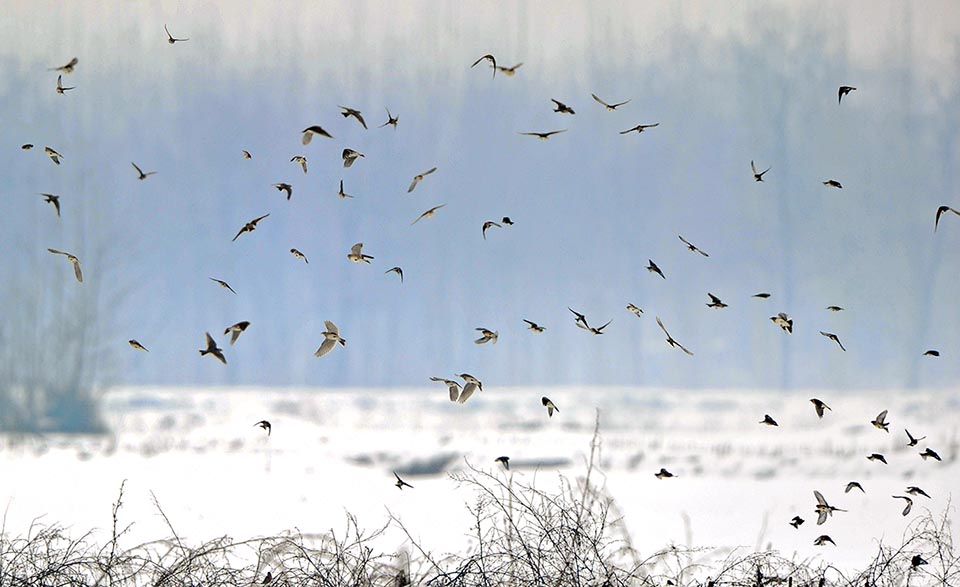
In case of unfavourable weather events like heavy snow we often see sudden migratory movements with flocks of hundreds of specimens © Gianfranco Colombo
The precociousness in leaving the nest is sometimes incredible and it is not rare the case, due to irrigations of the ground where it is placed or due to sudden floods, to see small featherless and isolated ones, scattered around the nest, to be able to survive remaining in the place where they have been tragically evicted.
Also in normal situations the nest is abandoned long before fledging that usually happens not less than two weeks.
The Lark is mainly insectivorous while nesting, but in the meantime it eats seeds and grains of all kinds, foods that become paramount during the winter.
Unfortunately the Lark has undergone during the last decades a drastic reduction, in particular in the European populations that have seen a violent change of the habitat due to the introduction of new agricultural crops.
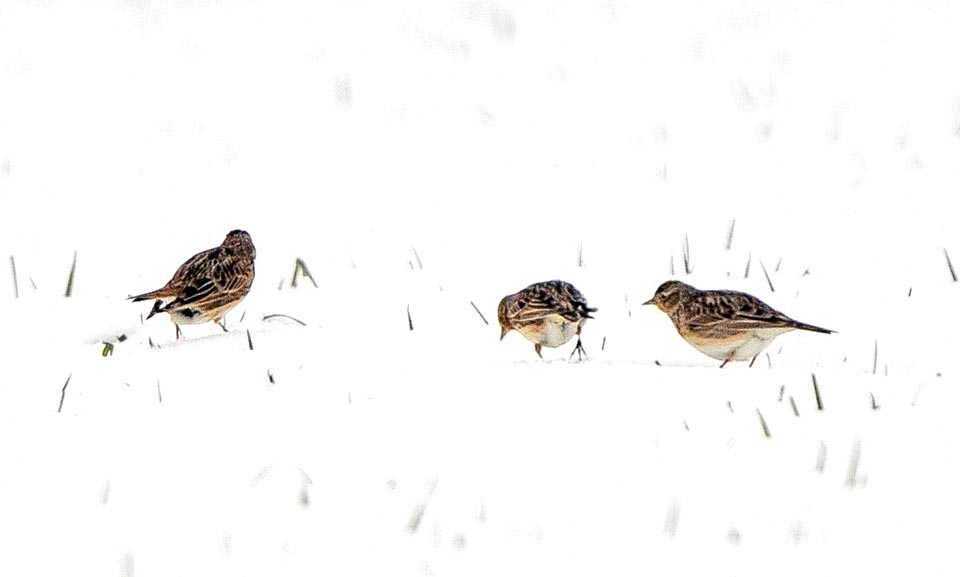
A Lombard tradition tells that lark resists in a site until when the snow cover does not exceed the length of blade of grass that she eats for surviving © Gianfranco Colombo
The corn monoculture and the disappearance of stable grasslands have been the main causes of its disappearance from the main plains of North Italy and of Mediterranean areas.
Despite being classified “Least concern”, that is at minimal risk of extinction in the Red List of the IUCN, this species displays a generalized decline all over the territory occupied, with disappearance almost total in vast European areas and in particular in North Italy.
Baudelaire claimed to envy the Lark due to its capacity of flying over the world stealing its secrets …. “and every morning, like the larks, rises in thoughts with freedom in the sky and hovers very high above life and has no difficulty in understanding the flowers and the other silent things!”
Simple and short verses, but intense and expressive like the song emitted by this tiny and nice little bird.
→ To appreciate the biodiversity within PASSERIFORMES please click here.
